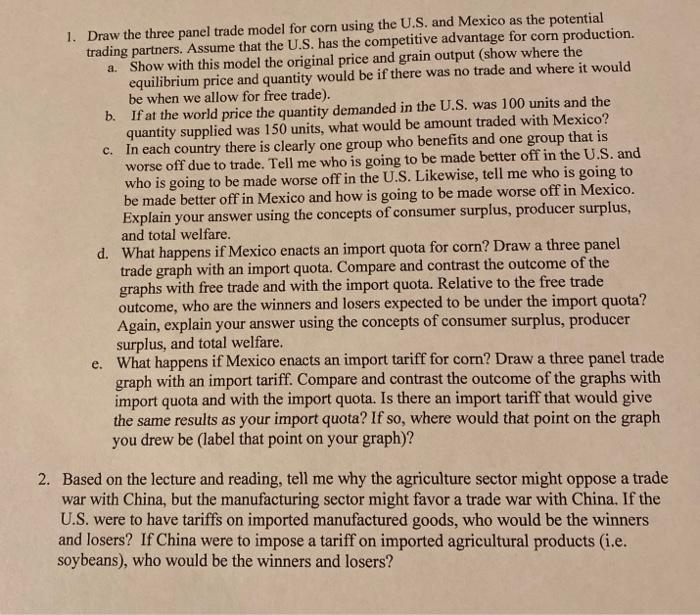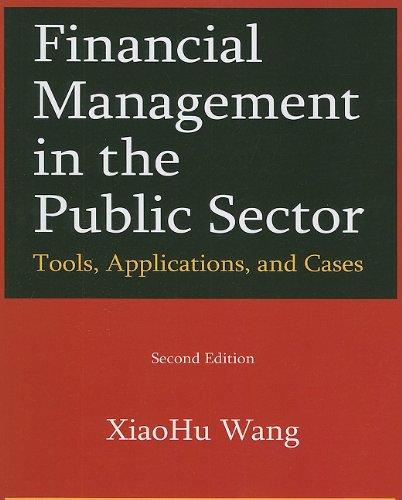1. Draw the three panel trade model for corn using the U.S. and Mexico as the potential trading partners. Assume that the U.S. has the competitive advantage for corn production. a. Show with this model the original price and grain output (show where the equilibrium price and quantity would be if there was no trade and where it would be when we allow for free trade). b. If at the world price the quantity demanded in the U.S. was 100 units and the quantity supplied was 150 units, what would be amount traded with Mexico? c. In each country there is clearly one group who benefits and one group that is worse off due to trade. Tell me who is going to be made better off in the U.S. and who is going to be made worse off in the U.S. Likewise, tell me who is going to be made better off in Mexico and how is going to be made worse off in Mexico. Explain your answer using the concepts of consumer surplus, producer surplus, and total welfare. d. What happens if Mexico enacts an import quota for corn? Draw a three panel trade graph with an import quota. Compare and contrast the outcome of the graphs with free trade and with the import quota. Relative to the free trade outcome, who are the winners and losers expected to be under the import quota? Again, explain your answer using the concepts of consumer surplus, producer surplus, and total welfare. e. What happens if Mexico enacts an import tariff for corn? Draw a three panel trade graph with an import tariff. Compare and contrast the outcome of the graphs with import quota and with the import quota. Is there an import tariff that would give the same results as your import quota? If so, where would that point on the graph you drew be (label that point on your graph)? 2. Based on the lecture and reading, tell me why the agriculture sector might oppose a trade war with China, but the manufacturing sector might favor a trade war with China. If the U.S. were to have tariffs on imported manufactured goods, who would be the winners and losers? If China were to impose a tariff on imported agricultural products (ie. soybeans), who would be the winners and losers? 1. Draw the three panel trade model for corn using the U.S. and Mexico as the potential trading partners. Assume that the U.S. has the competitive advantage for corn production. a. Show with this model the original price and grain output (show where the equilibrium price and quantity would be if there was no trade and where it would be when we allow for free trade). b. If at the world price the quantity demanded in the U.S. was 100 units and the quantity supplied was 150 units, what would be amount traded with Mexico? c. In each country there is clearly one group who benefits and one group that is worse off due to trade. Tell me who is going to be made better off in the U.S. and who is going to be made worse off in the U.S. Likewise, tell me who is going to be made better off in Mexico and how is going to be made worse off in Mexico. Explain your answer using the concepts of consumer surplus, producer surplus, and total welfare. d. What happens if Mexico enacts an import quota for corn? Draw a three panel trade graph with an import quota. Compare and contrast the outcome of the graphs with free trade and with the import quota. Relative to the free trade outcome, who are the winners and losers expected to be under the import quota? Again, explain your answer using the concepts of consumer surplus, producer surplus, and total welfare. e. What happens if Mexico enacts an import tariff for corn? Draw a three panel trade graph with an import tariff. Compare and contrast the outcome of the graphs with import quota and with the import quota. Is there an import tariff that would give the same results as your import quota? If so, where would that point on the graph you drew be (label that point on your graph)? 2. Based on the lecture and reading, tell me why the agriculture sector might oppose a trade war with China, but the manufacturing sector might favor a trade war with China. If the U.S. were to have tariffs on imported manufactured goods, who would be the winners and losers? If China were to impose a tariff on imported agricultural products (ie. soybeans), who would be the winners and losers







